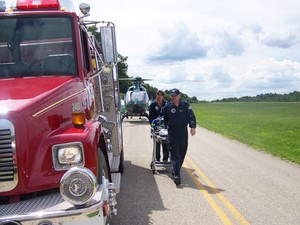Flight paramedics are often unsung heroes, who swoop in during a time of crisis, and transport critically injured patients to medical facilities. Flight paramedics exist in every county across the country, and are highly trained emergency personnel. Rural areas are often the most frequent locations to receive service from the highflying lifesavers. Hospitals are few and far between in the villages and small towns which dot the countryside, with flight paramedics offering the best chance of saving the life of a critically injured victim.
Pre-designated landing zones are typically established to aid in the response time of flight paramedic crews. Local fire departments and law enforcement set up a landing zone, and gear the flight crews to the safest location for a landing. Aside from flying and care giving, flight paramedics are often assisting with transporting patients from less than perfect locations. Flight paramedics have been known to climb hillsides, traverse waterways, and deep ravines to reach a patient.
Training and educational requirements for flight paramedics vary by state. The National Flight Paramedics Association is the driving force behind uniform standards and guidelines for the profession.
Currently there are nearly 1,500 working flight paramedics in the United States. There are two types of helicopters, which are used by flight paramedics, and include: 277 rotor winged helicopters, and fixed wing airplanes. The helicopter is generally used for flights of less than 300 nautical mile trips. Helicopters are the most frequently used modes of transportation for flight paramedics. Airplanes are utilized for far longer trips, and can be used to fly patients across states, or country borders.
The inside cab of a flight paramedic helicopter resembles a small emergency room. Standards in most states require a flight paramedic to possess at least five years of critical care experience. Potential flight paramedics with EMS experience are top candidates for the rapidly growing profession. A large number of women are choosing the rapid response emergency care job as a career.
Certificates and training credential which a flight paramedic are required to hold include: CPR based life support, ACLS, BTLS, PHTLS, PALS, ENPC, NAL, and TNCC. The higher level of care certificate of FP-C is a newly available training, and strongly encouraged for new and existing paramedics.
The challenging career holds all flight paramedics to a very high standard of continued training. Testing for each level of certification is stringent. Typically, nearly 300 applications are received for each opening in the highly competitive profession. Extensive background checks and behavioral reviews are given to applicants. Individuals with weak stomachs need not even apply. When a flight crew is called out, time is always of the essence, and patients are nearly always critically injured. Sometimes flight crews respond to calls to retrieve a victim from locations where an ambulance can’t travel. In such cases, the injury could be simply a broken leg, or heart attack.
Flight paramedics often have to face gruesome injuries, which can include severed limbs, and massive burns. The steadfast professions can be called to a scene of a two year old with both legs amputated by an accident, of a pregnant woman crushed inside of a vehicle. While it would only be human nature to be moved beyond expression when witnessing such sights, the well-trained professionals keep the scene as calm as possible, and quickly go about their work. Farm machinery accidents, ATV accidents, and multiple vehicle collisions are daily fare for the emergency flight crews.
The Association of Air Medical Services, and the National Flight Paramedics Association are the best resources those who are considering entering the profession. Both groups often host educational trainings and workshop. The annual Air Medical Transport Conference is held to bolster continued training, and offer safety presentations and certifications for flight paramedics. The skills required for flight paramedics are stringent, but the overall personality and calm under pressure are equally important for anyone who would like to take flight, and save lives. The sound of a hovering crew brings a wave of relief to not only the emergency responders on the ground, but to the patient and their family as well.
Resources for this article include: Personal observations from accident scenes, AAMS website, NFPA website, and conversations with emergency services personnel.



